-

Toward Wearable Cooling Devices: Highly Flexible Electrocaloric Ba0.67Sr0.33TiO3 Nanowire Arrays
2016 Advanced Materials
G. Z. Zhang, X. S. Zhang, H. B. Huang, J. J. Wang, Q. Li, L.-Q. Chen, and Q. Wang
Flexible lead-free ferroelectric ceramic nanowire arrays exhibit a unique combination of features that can contribute to the realization of wearable cooling devices, including an outstanding electrocaloric effect at low fields, high efficiency, bendability and stretchability, and robustness against mechanical deformations. Thermodynamic and phase-field simulations are carried out to validate their superior electrocaloric effect in comparison to thin films.
-

Observation of polar vortices in oxide superlattices
2016 Nature
A. K. Yadav, C. T. Nelson, S. L. Hsu, Z. Hong, J. D. Clarkson, C. M. Schleputz, A. R. Damodaran, P. Shafer, E. Arenholz, L. R. Dedon, D. Chen, A. Vishwanath, A. M. Minor, L.-Q. Chen, J. F. Scott, L. W. Martin, and R. Ramesh
The complex interplay of spin, charge, orbital and lattice degrees of freedom provides a plethora of exotic phases and physical phenomena. In recent years, complex spin topologies have emerged as a consequence of the electronic band structure and the interplay between spin and spin–orbit coupling in materials. Here we produce complex topologies of electrical polarization—namely, nanometre-scale vortex–antivortex (that is, clockwise–anticlockwise) arrays that are reminiscent of rotational spin topologies6—by making use of the competition between charge, orbital and lattice degrees of freedom in superlattices of alternating lead titanate and strontium titanate layers. Atomic-scale mapping of the polar atomic displacements by scanning transmission electron microscopy reveals the presence of long-range ordered vortex–antivortex arrays that exhibit nearly continuous polarization rotation. Phase-field modelling confirms that the vortex array is the low-energy state for a range of superlattice periods. Within this range, the large gradient energy from the vortex structure is counterbalanced by the corresponding large reduction in overall electrostatic energy (which would otherwise arise from polar discontinuities at the lead titanate/strontium titanate interfaces) and the elastic energy associated with epitaxial constraints and domain formation. These observations have implications for the creation of new states of matter (such as dipolar skyrmions, hedgehog states) and associated phenomena in ferroic materials, such as electrically controllable chirality.
-

Fast Magnetic Domain-Wall Motion in a Ring-Shaped Nanowire Driven by a Voltage
2016 Nano Letters
J.-M. Hu, T. N. Yang, K. Momeni, X. X. Cheng, L. Chen, S. M. Lei, S. J. Zhang, S. Trolier-McKinstry, V. Gopalan, G. P. Carman, C.-W. Nan, and L.-Q. Chen
Magnetic domain-wall motion driven by a voltage dissipates much less heat than by a current, but none of the existing reports have achieved speeds exceeding 100 m/s. Here phase-field and finite-element simulations were combined to study the dynamics of strain-mediated voltage-driven magnetic domain-wall motion in curved nanowires. Using a ring-shaped, rough-edged magnetic nanowire on top of a piezoelectric disk, we demonstrate a fast voltage-driven magnetic domain-wall motion with average velocity up to 550 m/s, which is comparable to current-driven wall velocity. An analytical theory is derived to describe the strain dependence of average magnetic domain-wall velocity. Moreover, one 180° domain-wall cycle around the ring dissipates an ultrasmall amount of heat, as small as 0.2 fJ, approximately 3 orders of magnitude smaller than those in current-driven cases. These findings suggest a new route toward developing high-speed, low-power-dissipation domain-wall spintronics.
-
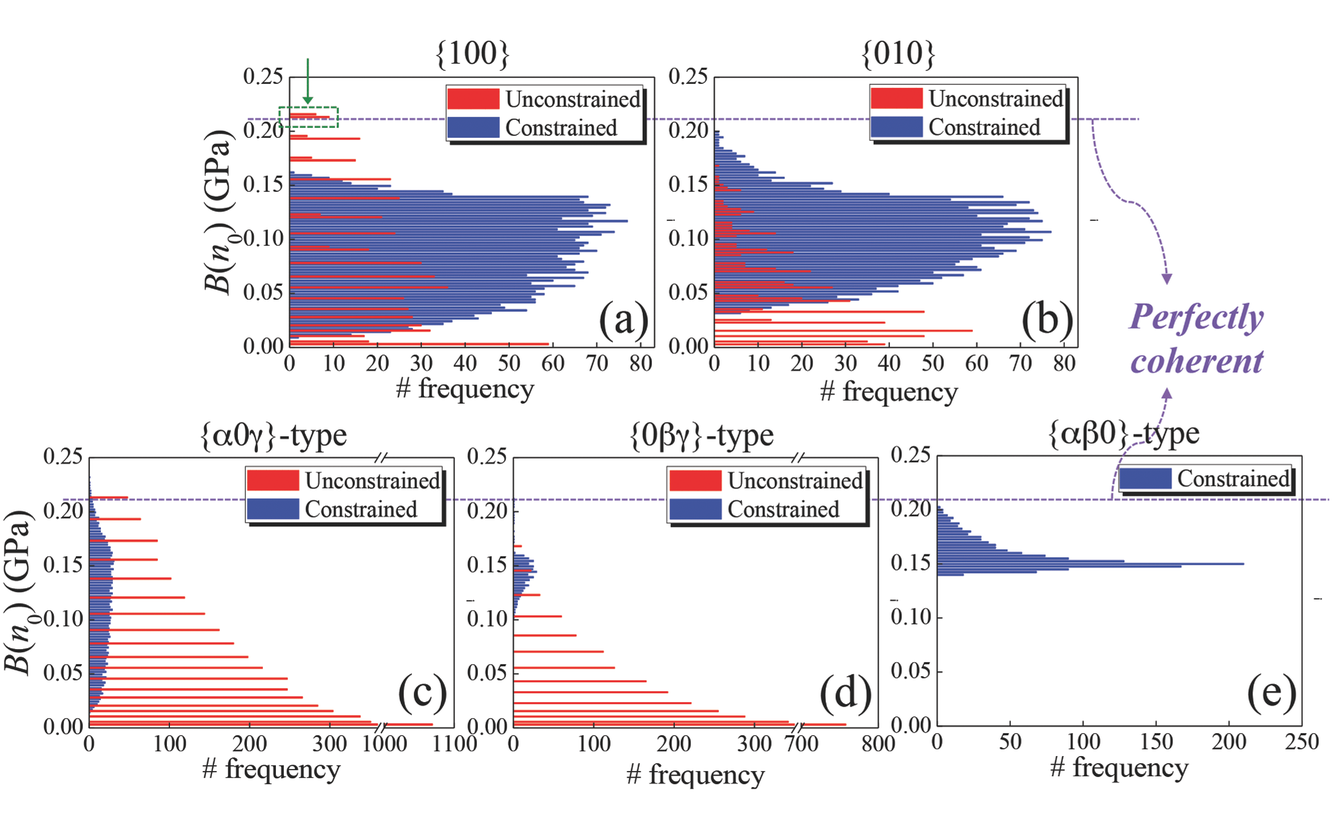
Defects, Entropy, and the Stabilization of Alternative Phase Boundary Orientations in Battery Electrode Particles
2016 Advanced Energy Materials
T. W. Heo, M. Tang, L.-Q. Chen, and B. C. Wood
Using a novel statistical approach that efficiently explores the space of possible defect configurations, the present study investigates the chemomechanical coupling between interfacial structural defects and phase boundary alignments within phase-separating electrode particles. Applied to the battery cathode material LiXFePO4 as an example, the theoretical analysis reveals that small, defect-induced deviations from an ideal interface can lead to dramatic shifts in the orientations of phase boundaries between Li-rich and Li-lean phases, stabilizing otherwise unfavorable orientations. Significantly, this stabilization arises predominantly from configurational entropic factors associated with the presence of the interfacial defects rather than from absolute energetic considerations. The specific entropic factors pertain to the diversity of defect configurations and their contributions to rotational/orientational rigidity of phase boundaries. Comparison of the predictions with experimental observations indicates that the additional entropy contributions indeed play a dominant role under actual cycling conditions, leading to the conclusion that interfacial defects must be considered when analyzing the stability and evolution kinetics of the internal phase microstructure of strongly phase-separating systems. Possible implications for tuning the kinetics of (de)lithiation based on selective defect incorporation are discussed. This understanding can be generalized to the chemomechanics of other defective solid phase boundaries.
-
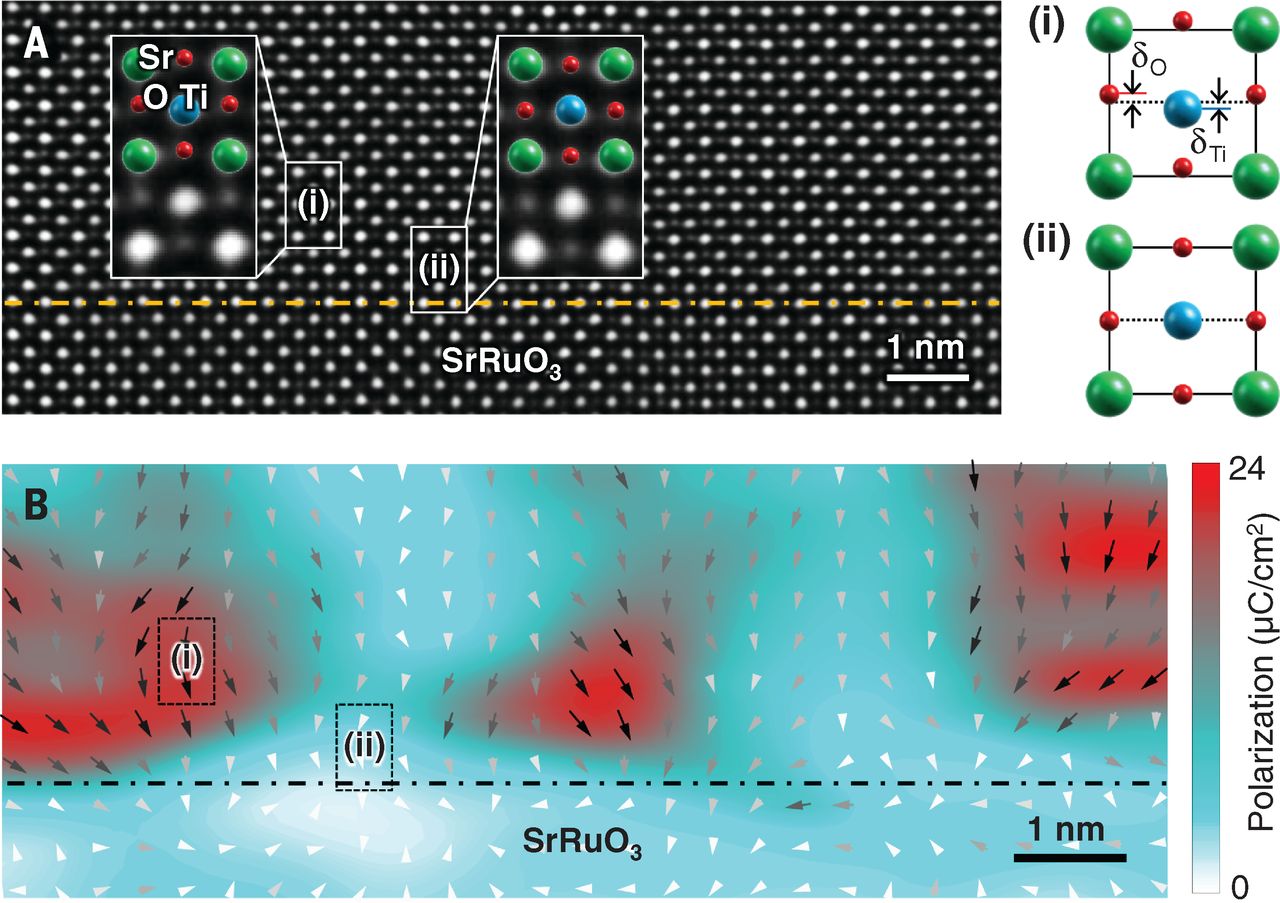
Emergence of room-temperature ferroelectricity at reduced dimensions
2015 Science
D. Lee, J. Lu, Y. J. Gu, S. Y. Choi, S.-D. Li, S. Ryu, T. R. Paudel, K. Song, E. Mikheev, S. Lee, S. Stemmer, D. A. Tenne, S. H. Oh, E. Y. Tsymbal, X. Wu, L.-Q. Chen, A. Gruverman, and C. B. Eom
The enhancement of the functional properties of materials at reduced dimensions is crucial for continuous advancements in nanoelectronic applications. Here, we report that the scale reduction leads to the emergence of an important functional property, ferroelectricity, challenging the long-standing notion that ferroelectricity is inevitably suppressed at the scale of a few nanometers. A combination of theoretical calculations, electrical measurements, and structural analyses provides evidence of room-temperature ferroelectricity in strain-free epitaxial nanometer-thick films of otherwise nonferroelectric strontium titanate (SrTiO3). We show that electrically induced alignment of naturally existing polar nanoregions is responsible for the appearance of a stable net ferroelectric polarization in these films. This finding can be useful for the development of low-dimensional material systems with enhanced functional properties relevant to emerging nanoelectronic devices.
-

Multiferroic magnetoelectric nanostructures for novel device applications
2015 MRS Bulletin
J.-M. Hu, T. X. Nan, N. X. Sun, and L.-Q. Chen
Multiferroic magnetoelectric nanostructures with coupled magnetization and electric polarization across their interfaces have stimulated intense research activities over the past decade. Such interface-based magnetoelectric coupling can be exploited to signifi cantly improve the performance of many devices such as memories, tunable radio-frequency/microwave devices, and magnetic sensors. In this article, we introduce a number of current or developing technologies and discuss their limitations. We describe how the use of magnetoelectric nanostructures can overcome these limitations to optimize device performance. We also present challenges that need to be addressed in pursuing practical applications of magnetoelectric devices.
-
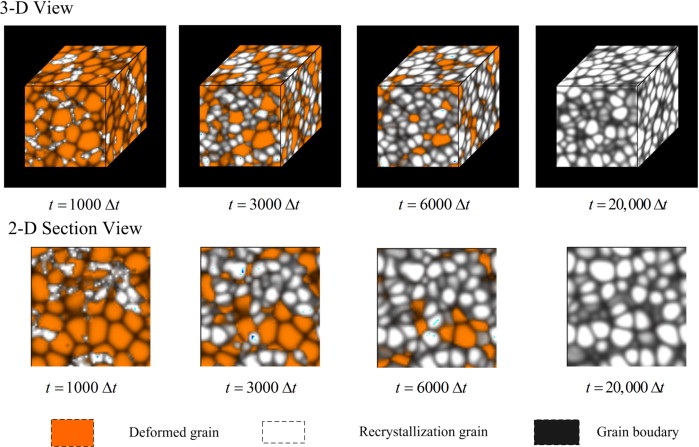
An integrated fast Fourier transform-based phase-field and crystal plasticity approach to model recrystallization of three dimensional polycrystals
2015 Computer Methods in Applied Mechanics and Engineering
L. Chen, J. Chen, R. A. Lebensohn, Y. Z. Ji, T. W. Heo, S. Bhattacharyya, K. Chang, S. Mathaudhu, Z. K. Liu, and L.-Q. Chen
A fast Fourier transform (FFT) based computational approach integrating phase-field method (PFM) and crystal plasticity (CP) is proposed to model recrystallization of plastically deformed polycrystals in three dimensions (3-D). CP at the grain level is employed as the constitutive description to predict the inhomogeneous distribution of strain and stress fields after plastic deformation of a polycrystalline aggregate while the kinetics of recrystallization is obtained employing a PFM in the plastically deformed grain structure. The elasto-viscoplastic equilibrium is guaranteed during each step of temporal phase-field evolution. Static recrystallization involving plasticity during grain growth is employed as an example to demonstrate the proposed computational framework. The simulated recrystallization kinetics is compared using the classical Johnson–Mehl–Avrami–Kolmogorov (JMAK) theory. This study also gives us a new computational pathway to explore the plasticity-driven evolution of 3D microstructures.
Our Group's Research areas
- Phase-field method and software development
- Multiscale modeling integrating density functional theory (DFT) calculations, thermodynamic analysis, and phase-field simulations
- Domain structures and switching in ferroelectric, ferromagnetic, ferroelastic and multiferroic thin films and devices
- Interactions between electronic/ionic defects and ferroelectric domains, dielectric degradation and breakdown
- Ion transport and microstructure evolution in solid electrodes and electrolytes in Li-ion batteries and solid oxide fuel cells (SOFC)
- Phase-field simulations of structural and diffusional phase transformations, grain growth, and Ostwald ripening in alloys
- Interactions between dislocations, plasticity, and phase microstructures
- Co-evolution of microstructure and properties
- Application of information technology to materials simulation and modeling
- Integrated computational materials science and engineering
News of Group
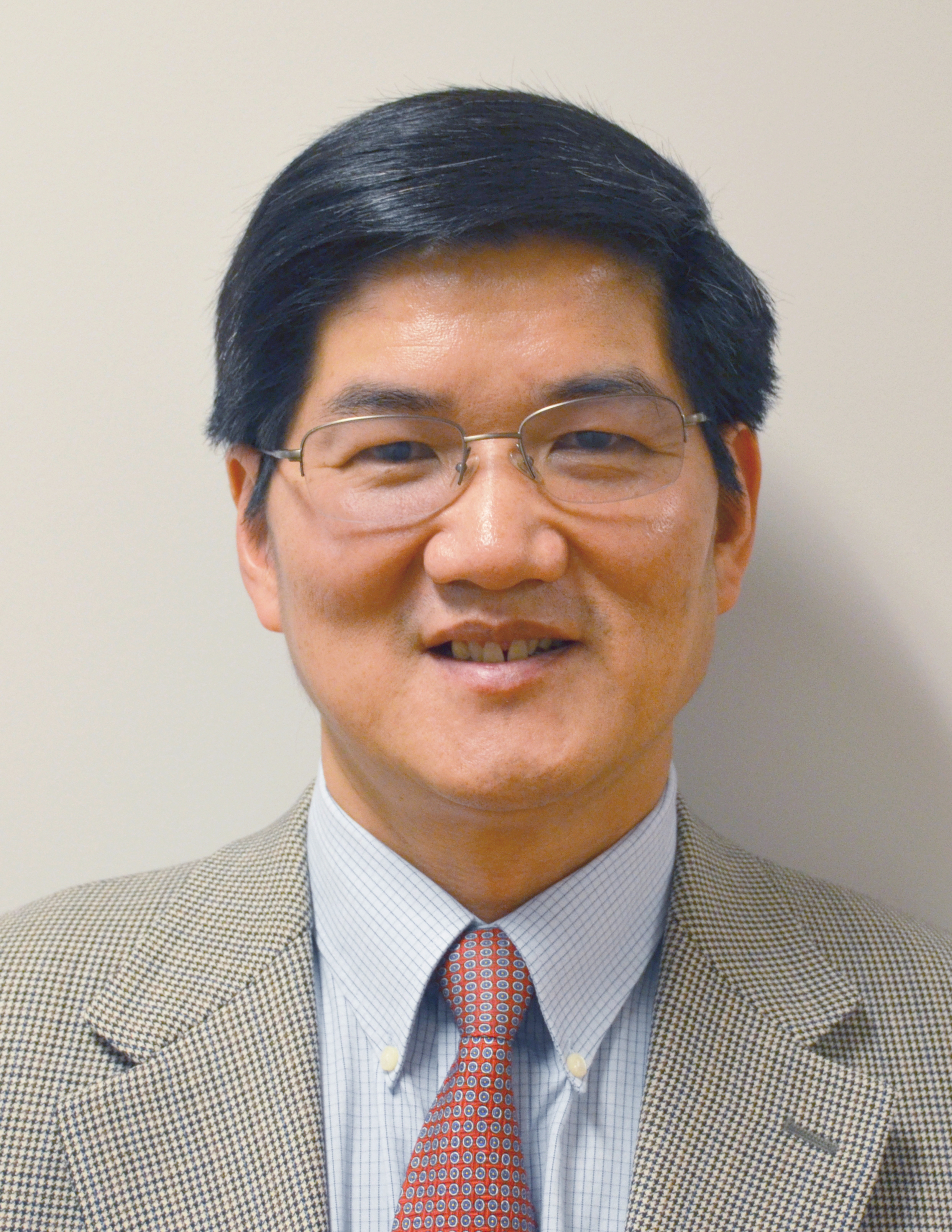 Congratulations Professor Long-Qing Chen receives 2014 Materials Theory Award (MRS Bulletin)
Congratulations Professor Long-Qing Chen receives 2014 Materials Theory Award (MRS Bulletin)
The Materials Research Society (MRS) has named Dr. Long-Qing Chen as the recipient for the 2014 Materials Theory Award for “his pioneering work in the development of the phase-field method and its applications in the computational modeling of mesoscale structures and their dynamics in inhomogeneous materials.” Chen will be recognized at the 2014 MRS Fall Meeting in Boston. Professor Chen will be giving a presentation for the award, "Understanding and Manipulating Mesoscale Ferroic Domain Patterns", Thursday, December 4, 6-6:45 p.m., Sheraton Boston Hotel, 2nd Floor, Grand Ballroom.
The Materials Theory Award, endowed by Toh-Ming Lu and Gwo-Ching Wang, “recognizes exceptional advances made by materials theory to the understanding of the structure and behavior of materials.” Congratulations to Professor Chen!
 Congratulations Yijia Gu received the Diamond Award of 2013
Congratulations Yijia Gu received the Diamond Award of 2013
Yijia Gu, a Ph.D. student working in Long-Qing Chen’s research group has received the Diamond Award for Graduate Excellence in Materials Science from the American Ceramic Society at the Materials Science and Technology Conference in October 2013. Congratulations to Yijia!
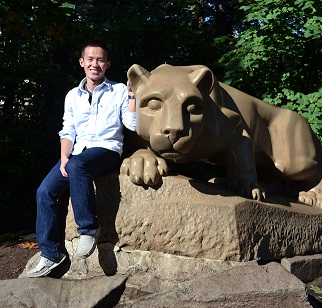 Congratulations Jiamian Hu received the Diamond Award of 2012
Congratulations Jiamian Hu received the Diamond Award of 2012
Jiamian Hu, a previous visiting scholar in the Long-Qing Chen research group from Tsinghua University has received the Diamond Award for Graduate Excellence in Materials Science at the Materials Science and Technology Conference in October 2012. Jiamian Hu is a graduate student at Tsinghua University working under the direction of Professor Cewen Nan. Jiamian visited Penn State for sixteen months to work under the direction of Professor Long-Qing Chen. Congratulations to Jiamian!


 Congratulations Professor Long-Qing Chen receives 2014 Materials Theory Award (MRS Bulletin)
Congratulations Professor Long-Qing Chen receives 2014 Materials Theory Award (MRS Bulletin) Congratulations Yijia Gu received the Diamond Award of 2013
Congratulations Yijia Gu received the Diamond Award of 2013 Congratulations Jiamian Hu received the Diamond Award of 2012
Congratulations Jiamian Hu received the Diamond Award of 2012






